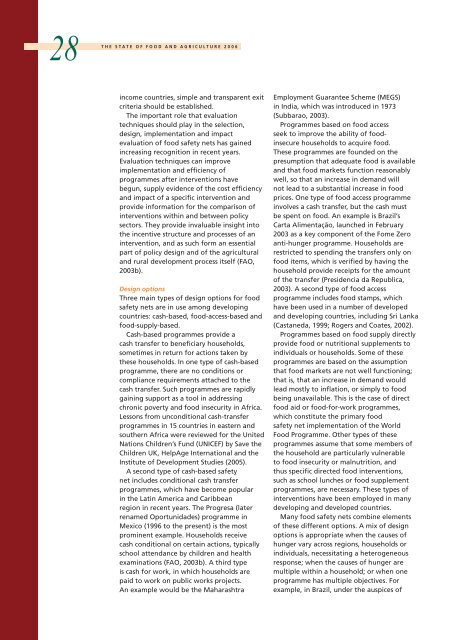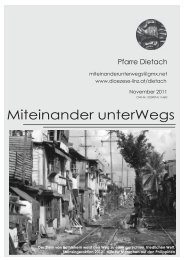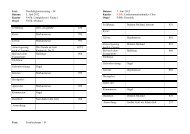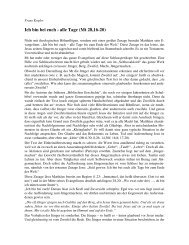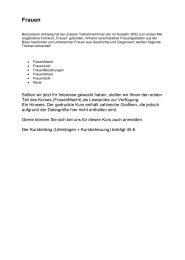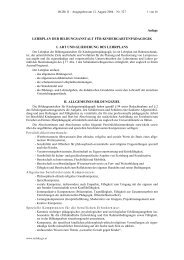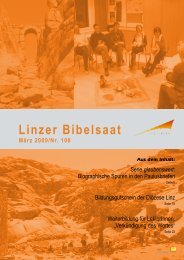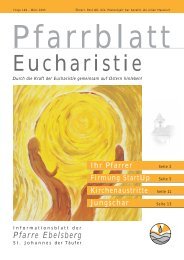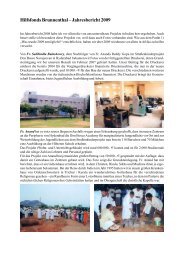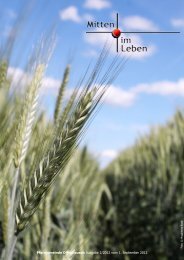The State of Food and Agriculture - FAO
The State of Food and Agriculture - FAO
The State of Food and Agriculture - FAO
Create successful ePaper yourself
Turn your PDF publications into a flip-book with our unique Google optimized e-Paper software.
28<br />
THE STATE OF FOOD AND AGRICULTURE 2006<br />
income countries, simple <strong>and</strong> transparent exit<br />
criteria should be established.<br />
<strong>The</strong> important role that evaluation<br />
techniques should play in the selection,<br />
design, implementation <strong>and</strong> impact<br />
evaluation <strong>of</strong> food safety nets has gained<br />
increasing recognition in recent years.<br />
Evaluation techniques can improve<br />
implementation <strong>and</strong> efficiency <strong>of</strong><br />
programmes after interventions have<br />
begun, supply evidence <strong>of</strong> the cost efficiency<br />
<strong>and</strong> impact <strong>of</strong> a specific intervention <strong>and</strong><br />
provide information for the comparison <strong>of</strong><br />
interventions within <strong>and</strong> between policy<br />
sectors. <strong>The</strong>y provide invaluable insight into<br />
the incentive structure <strong>and</strong> processes <strong>of</strong> an<br />
intervention, <strong>and</strong> as such form an essential<br />
part <strong>of</strong> policy design <strong>and</strong> <strong>of</strong> the agricultural<br />
<strong>and</strong> rural development process itself (<strong>FAO</strong>,<br />
2003b).<br />
Design options<br />
Three main types <strong>of</strong> design options for food<br />
safety nets are in use among developing<br />
countries: cash-based, food-access-based <strong>and</strong><br />
food-supply-based.<br />
Cash-based programmes provide a<br />
cash transfer to beneficiary households,<br />
sometimes in return for actions taken by<br />
these households. In one type <strong>of</strong> cash-based<br />
programme, there are no conditions or<br />
compliance requirements attached to the<br />
cash transfer. Such programmes are rapidly<br />
gaining support as a tool in addressing<br />
chronic poverty <strong>and</strong> food insecurity in Africa.<br />
Lessons from unconditional cash-transfer<br />
programmes in 15 countries in eastern <strong>and</strong><br />
southern Africa were reviewed for the United<br />
Nations Children’s Fund (UNICEF) by Save the<br />
Children UK, HelpAge International <strong>and</strong> the<br />
Institute <strong>of</strong> Development Studies (2005).<br />
A second type <strong>of</strong> cash-based safety<br />
net includes conditional cash transfer<br />
programmes, which have become popular<br />
in the Latin America <strong>and</strong> Caribbean<br />
region in recent years. <strong>The</strong> Progresa (later<br />
renamed Oportunidades) programme in<br />
Mexico (1996 to the present) is the most<br />
prominent example. Households receive<br />
cash conditional on certain actions, typically<br />
school attendance by children <strong>and</strong> health<br />
examinations (<strong>FAO</strong>, 2003b). A third type<br />
is cash for work, in which households are<br />
paid to work on public works projects.<br />
An example would be the Maharashtra<br />
Employment Guarantee Scheme (MEGS)<br />
in India, which was introduced in 1973<br />
(Subbarao, 2003).<br />
Programmes based on food access<br />
seek to improve the ability <strong>of</strong> foodinsecure<br />
households to acquire food.<br />
<strong>The</strong>se programmes are founded on the<br />
presumption that adequate food is available<br />
<strong>and</strong> that food markets function reasonably<br />
well, so that an increase in dem<strong>and</strong> will<br />
not lead to a substantial increase in food<br />
prices. One type <strong>of</strong> food access programme<br />
involves a cash transfer, but the cash must<br />
be spent on food. An example is Brazil’s<br />
Carta Alimentação, launched in February<br />
2003 as a key component <strong>of</strong> the Fome Zero<br />
anti-hunger programme. Households are<br />
restricted to spending the transfers only on<br />
food items, which is verified by having the<br />
household provide receipts for the amount<br />
<strong>of</strong> the transfer (Presidencia da Republica,<br />
2003). A second type <strong>of</strong> food access<br />
programme includes food stamps, which<br />
have been used in a number <strong>of</strong> developed<br />
<strong>and</strong> developing countries, including Sri Lanka<br />
(Castaneda, 1999; Rogers <strong>and</strong> Coates, 2002).<br />
Programmes based on food supply directly<br />
provide food or nutritional supplements to<br />
individuals or households. Some <strong>of</strong> these<br />
programmes are based on the assumption<br />
that food markets are not well functioning;<br />
that is, that an increase in dem<strong>and</strong> would<br />
lead mostly to inflation, or simply to food<br />
being unavailable. This is the case <strong>of</strong> direct<br />
food aid or food-for-work programmes,<br />
which constitute the primary food<br />
safety net implementation <strong>of</strong> the World<br />
<strong>Food</strong> Programme. Other types <strong>of</strong> these<br />
programmes assume that some members <strong>of</strong><br />
the household are particularly vulnerable<br />
to food insecurity or malnutrition, <strong>and</strong><br />
thus specific directed food interventions,<br />
such as school lunches or food supplement<br />
programmes, are necessary. <strong>The</strong>se types <strong>of</strong><br />
interventions have been employed in many<br />
developing <strong>and</strong> developed countries.<br />
Many food safety nets combine elements<br />
<strong>of</strong> these different options. A mix <strong>of</strong> design<br />
options is appropriate when the causes <strong>of</strong><br />
hunger vary across regions, households or<br />
individuals, necessitating a heterogeneous<br />
response; when the causes <strong>of</strong> hunger are<br />
multiple within a household; or when one<br />
programme has multiple objectives. For<br />
example, in Brazil, under the auspices <strong>of</strong>


